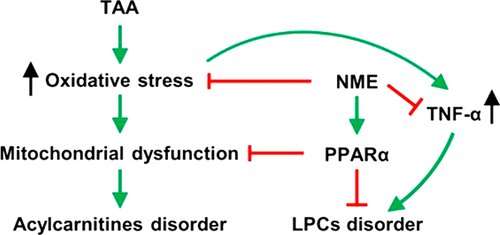Nutmeg's hidden power: Helping the liver

Smelling nutmeg evokes images of fall, pumpkin pie and hot apple cider. But the spice has been used for years in traditional Chinese medicine to treat gastrointestinal illnesses. Now one group reports in ACS' Journal of Proteome Research that they have figured out how nutmeg helps other organs, specifically the liver.
According to the Food and Agriculture Organization of the United Nations, the world consumes 9,000 tons of nutmeg annually. Nutmeg is the seed of the Myristica fragrans tree, which is commonly found in Indonesia, and has been used to treat asthma, rheumatic pain, toothaches and infections. In the laboratory, researchers have shown that nutmeg can fight hyperlipidaemia, hyperglycemia, heart tissue damage and hepatotoxicity. Inspired by these studies, Xiu-Wei Yang, Frank Gonzalez, Fei Li and colleagues wanted to see how nutmeg prevents damage to the liver.
The researchers used a mouse animal model of liver toxicity to test the mechanism behind nutmeg's protective effects. Metabolomics analyses showed that nutmeg likely protected against liver damage by restoring the mice to more healthy levels of various lipids and acylcarnitines. Gene expression studies showed that peroxisome proliferator-activated receptor alpha (PPARα) was modulated by nutmeg, and the spice didn't protect mice from liver injury if the PPARα gene was deleted. In addition, the team found that a specific compound in nutmeg, myrislignan, had a strong protective effect against liver damage.
More information: Xiao-Nan Yang et al. PPARα Mediates the Hepatoprotective Effects of Nutmeg, Journal of Proteome Research (2018). DOI: 10.1021/acs.jproteome.7b00901
Abstract
Nutmeg is a Traditional Chinese Medicine used to treat gastrointestinal diseases. Some reports have indicated that nutmeg has hepatoprotective activity. In this study, a thioacetamide (TAA)-induced acute liver injury model in mice was used to explore the mechanism of the protective effects of nutmeg extract (NME), including its major bioactive component myrislignan. The results indicated that NME could effectively protect TAA-induced liver damage as assessed by recovery of increased serumtransaminases, decrease in hepatic oxidative stress, and lower hepatic inflammation. Metabolomics analysis further revealed that treatment with NME led to the recovery of a series of lipids including lysophosphatidylcholines that were decreased and a lowering of acylcarnitines that were increased in mouse plasma and liver after TAA exposure. Gene expression analysis demonstrated that the hepatoprotective effect of NME was achieved by modulation of the peroxisome proliferator-activated receptor alpha (PPARα) as well as the decrease in oxidative stress. NME could not protect from TAA-induced liver injury in Ppara-null mice, suggesting that its protective effect was dependent on PPARα. Myrislignan, a representative neolignan in nutmeg, showed potent protective activity against TAA-induced liver toxicity. These data demonstrate that nutmeg alleviates TAA-induced liver injury through the modulation of PPARα and that the lignan compounds in nutmeg such as myrislignan partly contributed to this action.
Journal information: Journal of Proteome Research
Provided by American Chemical Society

















